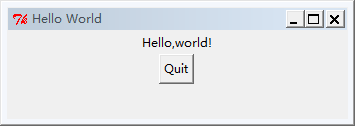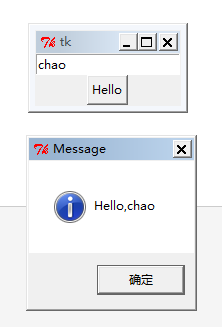python基础-图形界面库
Python 支持多种图形界面的第三方库:Tk、wxWidgets、Qt、GTK
Python自带的库是支持Tk的Tkinter,使用Tkinter,无需安装任何包,就可以直接使用
内置的Tkinter封装了访问Tk的接口:
Tk是一个图形库,支持多个操作系统,使用Tcl语言开发;
Tk会调用操作系统提供的本地GUI接口,完成最终的GUI。
所以,代码只需要调用Tkinter提供的接口就可以了。
编写Hello World!
from Tkinter import * #从Frame派生一个Application类,是所有Widget的父容器 class Application(Frame): def __init__(self, master=None): Frame.__init__(self, master) self.pack() self.createWidgets() #每个Button、Label、输入框等,都是一个Widget。Frame则是可以容纳其他Widget的Widget,所有的Widget组合起来就是一棵树 def createWidgets(self): self.helloLabel = Label(self, text='Hello, world!') self.helloLabel.pack() #pack()方法把Widget加入到父容器中,并实现布局,grid()可以实现更复杂的布局 self.quitButton = Button(self, text='Quit', command=self.quit) #当Button被点击时,触发self.quit()使程序退出 self.quitButton.pack() #实例化Application,并启动消息循环 app = Application() # 设置窗口标题: app.master.title('Hello World') # 主消息循环: app.mainloop() #GUI程序的主线程负责监听来自操作系统的消息,并依次处理每一条消息。因此,如果消息处理非常耗时,就需要在新线程中处理
运行如图所示:

输入文本:
from Tkinter import * import tkMessageBox class Application(Frame): def __init__(self, master=None): Frame.__init__(self, master) self.pack() self.createWidgets() def createWidgets(self): self.nameInput = Entry(self) self.nameInput.pack() self.alertButton = Button(self, text='Hello', command=self.hello) self.alertButton.pack() def hello(self): name = self.nameInput.get() or 'world' tkMessageBox.showinfo('Message', 'Hello, %s' % name) #点击按钮时,触发hello(),通过self.nameInput.get()获得用户输入的文本后,使用tkMessageBox.showinfo()可以弹出消息对话框。
如图:







【推荐】还在用 ECharts 开发大屏?试试这款永久免费的开源 BI 工具!
【推荐】国内首个AI IDE,深度理解中文开发场景,立即下载体验Trae
【推荐】编程新体验,更懂你的AI,立即体验豆包MarsCode编程助手
【推荐】抖音旗下AI助手豆包,你的智能百科全书,全免费不限次数
【推荐】轻量又高性能的 SSH 工具 IShell:AI 加持,快人一步